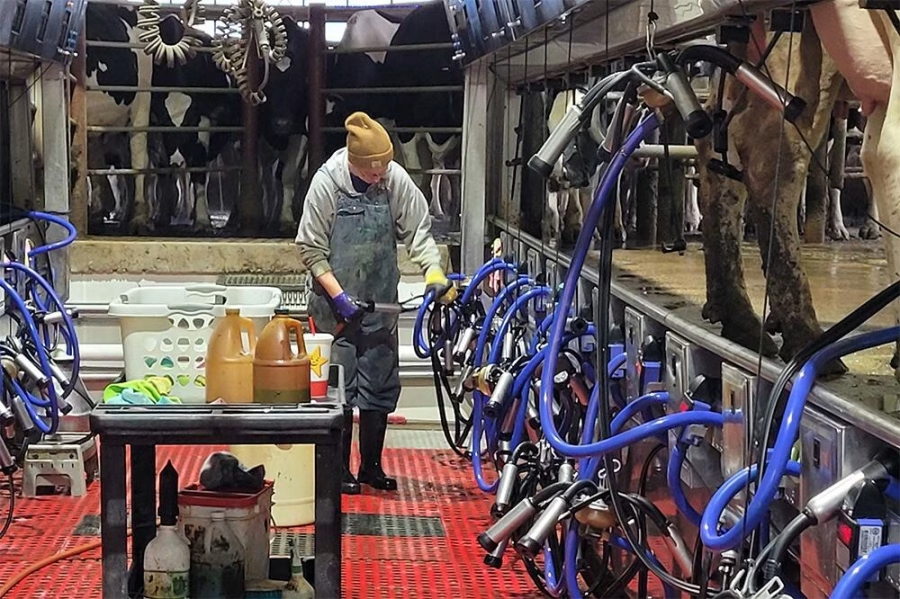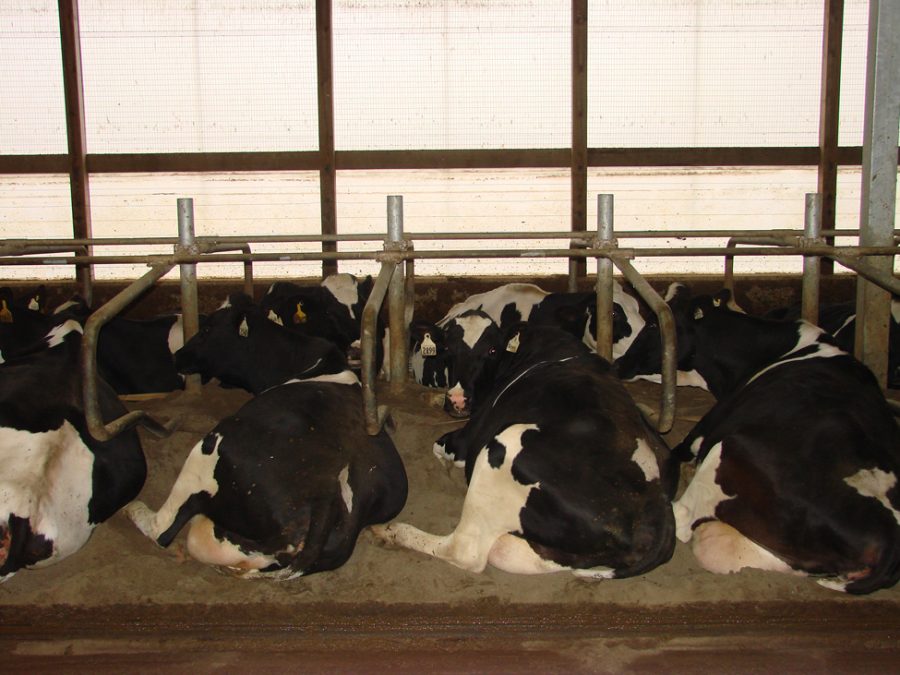Find out why the Iowa Supreme Court upheld a $4.75 million award for a dairy farm harmed by stray electricity. What does this important case mean for the dairy industry?

The Iowa Supreme Court has upheld a $4.75 million verdict for Vagts Dairy, an Iowa farm impacted by stray voltage from a nearby gas pipeline. This landmark decision not only marks a pivotal win for the family, addressing years of losses in their dairy operations but also draws attention to infrastructure-induced problems for agricultural communities.
“Sometimes you get to the point you don’t even want to get up in the morning because you don’t know what you’re going to find out there,” Mark Vagts testified, underscoring the family’s unwavering determination in the face of daily challenges.
The Price of Protection: How an Essential Pipeline System Became a Dairy’s Worst Nightmare
Vagts Dairy, run by Mark, Joan, and Andrew Vagts, faced severe challenges due to alleged stray voltage, which refers to the presence of unwanted electrical energy from Northern Natural Gas Company’s pipeline. This pipeline’s corrosion-prevention system reportedly caused electrical issues that impacted their dairy herd. The Vagts family filed a lawsuit in 2021, seeking compensation for their livestock and livelihood damage.
Decades of Protection Turned Enigma: The Historical Backdrop of a Landmark Case
This case involves a pipeline built 60 years ago, stretching about 14,000 miles from Texas to Michigan. It includes an electrical system, known as a cathodic protection system, required by federal regulations to prevent corrosion. This system uses a low-level electrical current to counteract the natural corrosion tendency of metals in a conductive environment.
2013: The Year of Unwanted Currents and Deepening Woes
The onset of issues can be traced back to 2013 when part of the electrical system was replaced. This marked the beginning of troubling times for the Vagts’ dairy farm. The cows started showing abnormal behavior and health problems, their milk production dropped, and mortality rates soared, plunging the dairy operators into distress and uncertainty.
2017: A Year of Ambitious Growth Met with Unforeseen Challenges
In 2017, the Vagts expanded their dairy, extending a barn closer to the electrical system. This move, part of their ambitious growth plan to increase milk production, worsened the stray voltage issue, severely affecting their herd. By 2022, over 17 percent of their cattle had died, far above the typical 5 percent mortality rate. The cows showed unusual behavior, like standing in waterers to avoid electric shocks and refusing milking equipment. The financial and physical toll was enormous, highlighting the devastation stray voltage can cause if unchecked.
Pain and Resilience: Heartfelt Testimonies Highlight the Human Cost of Stray Voltage
During the January 2023 trial, Mark Vagts shared the toll the situation had on their dairy and personal lives. “Sometimes you don’t even want to get up in the morning because you don’t know what you’re going to find out there,” he said, highlighting the daily stress and uncertainty.
Andrew Vagts added, “What sucks is telling my kids why their fair calf had to be shot or put down or sold.” His testimony illuminated the emotional burden on their family, particularly on the younger generation, emphasizing the personal cost of the stray voltage issue. This emotional toll, in addition to the financial and physical losses, underscores the severity of the issue.
Vindication and Remediation: Jury Awards $4.75 Million to Vagts Family
The jury awarded the Vagts family $4.75 million: $3 million for economic damages, $1.25 million for personal inconvenience and discomfort, which includes the emotional distress and disruption to their daily lives caused by the stray voltage issue, and $500,000 for loss of use and enjoyment of their property, which includes the impact on their ability to use and enjoy their farm due to the stray voltage issue.
An Acrimonious Battle Over Damages: The Company’s Counter-Arguments and Legal Maneuvering
Despite the jury’s decision, Northern Natural Gas Company disputed the claims, questioning the link between their electrical system and the cows’ ailments. They argued that the Vagts family didn’t definitively prove that the pipeline caused their dairy cows’ issues and economic losses. The company also challenged the damages awarded, claiming the amount lacked sufficient evidence. On appeal, they insisted negligence was necessary to establish liability for the nuisance.
Majority Opinion: Upholding Justice Through Established Records, Beyond Negligence Requirements
Justice Christopher McDonald, writing for the majority, upheld the jury’s verdict, confirming it was well-supported by the record. He clarified that proving negligence was unnecessary to establish a nuisance in this case.
In his separate opinion, Justice Edward Mansfield agreed with the majority on procedural grounds. Still, he emphasized that negligence should have been a critical consideration. He argued that the unique vulnerability of dairy cattle to electrical currents, which can cause significant health issues and even death, creates an unusual nuisance scenario. He believed this required reevaluating how negligence is factored into such cases.
The Tightrope of Tradition: Justice Mansfield’s Call for Caution in Expanding Nuisance Law
Justice Edward Mansfield cautioned against expanding the strict liability nuisance law, which holds a party liable for damages regardless of fault, stressing the importance of sticking to long-standing legal precedents. He argued that courts should balance fair compensation for significant damage with maintaining established legal frameworks. Mansfield warned that shifting from traditional precedents might necessitate considering negligence in future cases involving sensitive issues, such as those impacting dairy cattle.
The Bottom Line
The Iowa Supreme Court’s $4.75 million verdict for Vagts Dairy underscores how stray voltage impacts farms, particularly livestock health and productivity. This ruling vindicates the Vagts family after years of turmoil and highlights the complexities of nuisance law in agriculture.
The Vagts, through testimonies and expert opinions, showed the connection between Northern Natural Gas Company’s pipeline and their dairy herd’s decline. The jury’s award highlights the contentious nature of liability and damages in environmental cases.
The justices’ disagreement on proving negligence in nuisance claims signals a need for a balanced interpretation of strict liability principles versus legal precedents, setting a precedent for similar disputes in the future.
Key Takeaways:
- The Iowa Supreme Court upheld a $4.75 million jury verdict for Vagts Dairy, affirming the significant impact of stray voltage from Northern Natural Gas Company’s pipeline.
- Justice Christopher McDonald’s opinion emphasized that negligence was not a required finding for creating a nuisance in this case, highlighting the jury’s award as well-supported by evidence.
- Justice Edward Mansfield concurred with the verdict but cautioned against expanding strict-liability nuisance law, arguing that negligence should have been considered.
- The Vagts experienced severe disruptions to their dairy operations, including abnormal cattle behavior, elevated mortality rates, and reduced milk production.
- The legal dispute centered around whether Northern Natural Gas Company’s corrosion-protection electrical system caused the stray voltage affecting the dairy farm.
Summary:
The Iowa Supreme Court has upheld a $4.75 million verdict for Vagts Dairy, an Iowa farm affected by stray voltage from a nearby gas pipeline. The Vagts family, run by Mark, Joan, and Andrew Vagts, faced severe challenges due to alleged stray voltage, which refers to the presence of unwanted electrical energy from Northern Natural Gas Company’s pipeline. The pipeline’s corrosion-prevention system reportedly caused electrical issues that impacted their dairy herd. The onset of issues can be traced back to 2013 when part of the electrical system was replaced, leading to abnormal behavior, health problems, decreased milk production, and soared mortality rates. In 2017, the Vagts expanded their dairy, extending a barn closer to the electrical system, which worsened the stray voltage issue. By 2022, over 17% of their cattle had died, exceeding the typical 5% mortality rate.












